-
Reagents
- Flow Cytometry Reagents
-
Western Blotting and Molecular Reagents
- Immunoassay Reagents
-
Single-Cell Multiomics Reagents
- BD® OMICS-Guard Sample Preservation Buffer
- BD® AbSeq Assay
- BD® Single-Cell Multiplexing Kit
- BD Rhapsody™ ATAC-Seq Assays
- BD Rhapsody™ Whole Transcriptome Analysis (WTA) Amplification Kit
- BD Rhapsody™ TCR/BCR Next Multiomic Assays
- BD Rhapsody™ Targeted mRNA Kits
- BD Rhapsody™ Accessory Kits
- BD® OMICS-One Protein Panels
- BD OMICS-One™ WTA Next Assay
-
Functional Assays
-
Microscopy and Imaging Reagents
-
Cell Preparation and Separation Reagents
Old Browser
This page has been recently translated and is available in French now.
Looks like you're visiting us from {countryName}.
Would you like to stay on the current location site or be switched to your location?

Biosimilar Antibodies for Research
What are Biosimilar Antibodies?
To support research on existing therapeutic antibodies, investigators benefit from having an accessible and cost-effective alternative to using prescription drugs for their basic research. Biosimilar antibodies have identical variable sequences to FDA-approved therapeutic antibodies and can thus be used as convenient surrogates in basic research settings.
Get more information from the Biosimilar Antibodies for Immunotherapy Research and Development flyer
How are Biosimilar Antibodies Used in Research?
Research-grade biosimilar antibodies are used to understand how therapeutic antibodies work, with the goal of designing the next generation of antibody-based biologics. Functional studies probe mechanism(s) of action of a therapeutic antibody and require a biosimilar with wildtype Fc sequence for intact effector functions. Alternatively, biosimilars can be optimized for flow cytometry by mutating the Fc region to reduce background Fc receptor binding and support investigations that examine target location and modulation. BD Biosciences offers both biosimilar versions to support these distinct avenues of investigation.
Biosimilars for Functional Studies
| Some examples of functional studies using biosimilars include:
| Our wildtype biosimilar products feature:
|
Induction of Cellular Cytotoxicity
Research-grade biosimilars enable investigators to explore various cellular processes that a given therapeutic antibody relies upon. For example, the following experiment demonstrates that Rituximab primarily uses complement-mediated cytotoxicity (CDC), while Obinutuzumab elicits direct cell death (DCD) and/or antibody-dependent cellular toxicity (ADCC).
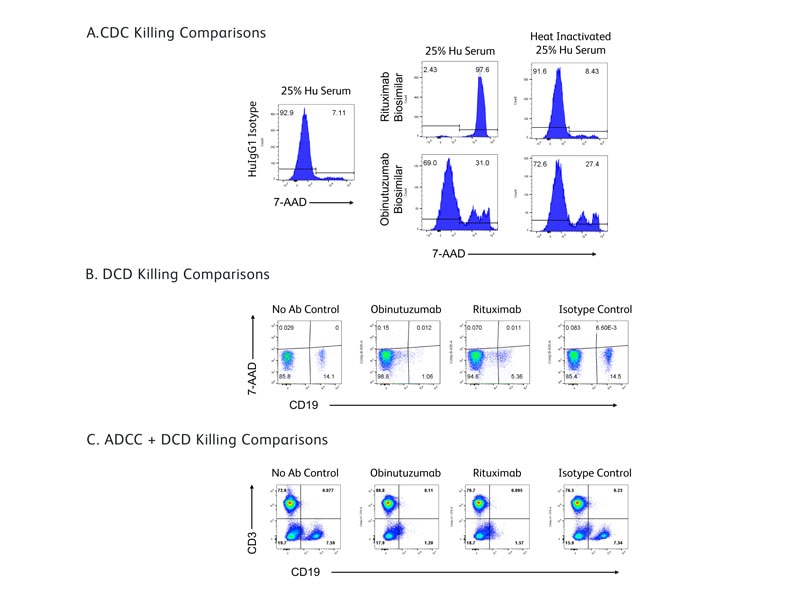
Blockade of Key Cell Functions
A variety of therapeutic antibody effects can be modeled with sodium-azide-free, low endotoxin (NA/LE) biosimilars. Trastuzumab inhibition of breast cancer cell (SK-BR-3) growth was assessed as decrease in MTT colorimetric reading. Vedolizumab blockade of LPAM-1 integrin was determined by decrease of HUT-78 cell adhesion to MAdCAM-1. Adalimumab or infliximab blockade of TNF-α-induced cell death was demonstrated by restoration of L929 cell growth by MTT assay.
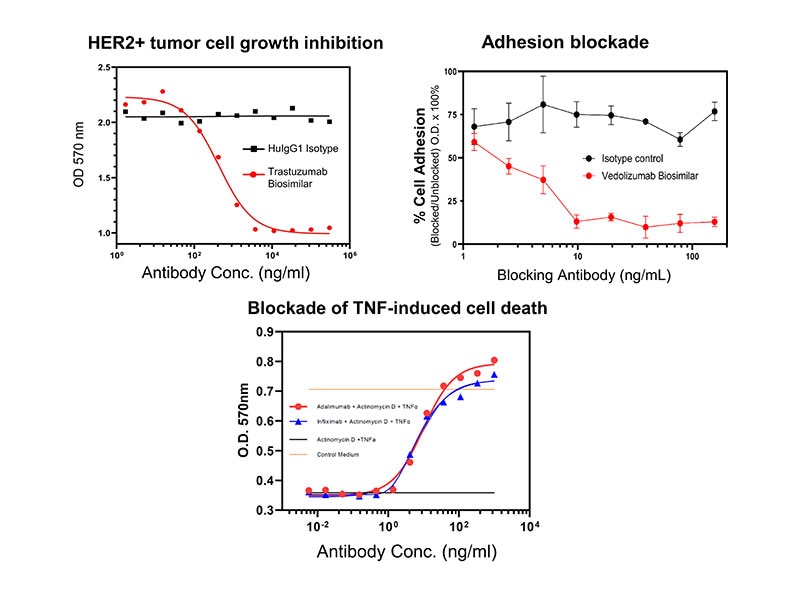
Target Identification and Modulation
Therapeutic antibody treatment can result in downregulation of cell surface targets through various endocytic pathways. In this context, monitoring the expression of the target protein becomes critical to ensure therapeutic success. This task is challenging when using the same antibody clone for analysis as the therapeutic, or a clone that competes for binding to the same epitope. To avoid this problem, non-competing fluorochrome-conjugated antibodies have emerged as a solution to accurately measure the expression of such targets, whether in the presence or absence of a therapeutic antibody or equivalent biosimilar.
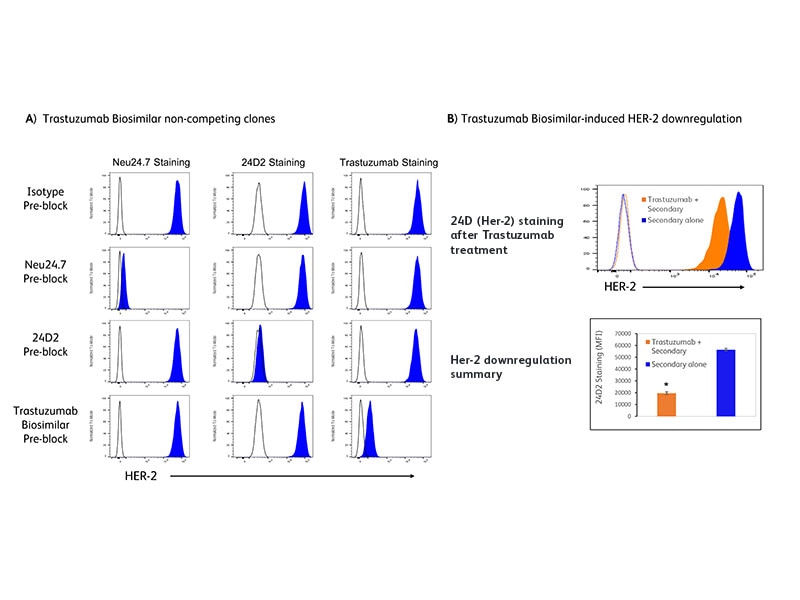
Flow Cytometry Optimized Biosimilar Antibodies
The Value of Fc-Mutated Biosimilar Antibodies in Flow Cytometry-Based Assays
Flow cytometry optimized BD Biosciences biosimilar antibodies have a point mutation (N279A) in the Fc region to prevent Fc gamma receptor binding, thereby reducing non-specific background signals and unwanted Fc-mediated effector functions.
The combination of low background staining and availability in a wide range of fluorochrome options allows BD biosimilars to be used in a diverse array of applications such as:
|
|
Reduced Background Staining in Flow Cytometry with Optimized Fc-mutated Biosimilars
Fc receptor interference can obscure the study of therapeutic antibody target specificity. Using Fc-mutated biosimilars reduces the impact of background signals, offering cleaner data on cell staining applications.
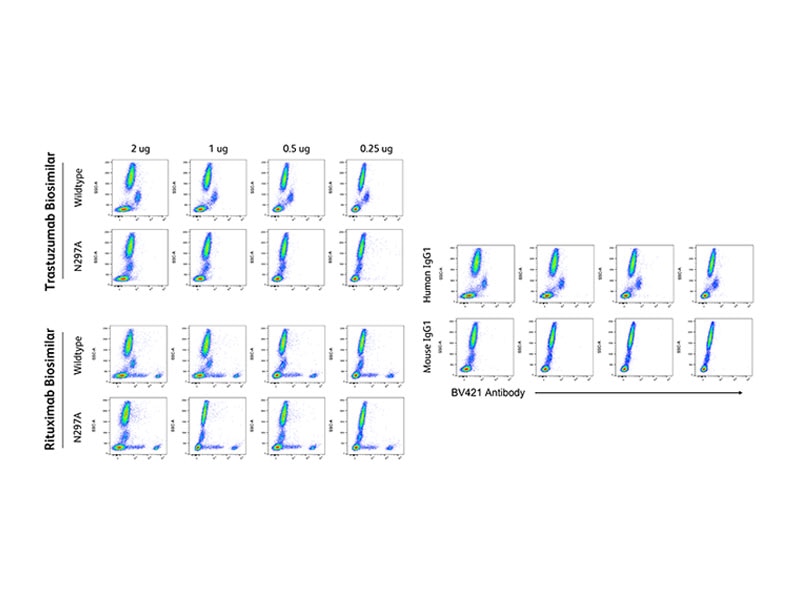
Target Identification and Subcellular Localization
Soluble proteins such as cytokines (e.g., TNF, IL-12/23, IL-1, VEGF) can also be detected intracellularly, or in membrane-bound states in some cases. Identifying membrane-bound states is critical for the success of target therapies, in which both soluble and transmembrane proteins (through cell-cell interactions) can equally trigger cellular processes. Determining which cells express membrane-bound targets is also important for predicting specific cytotoxicity.
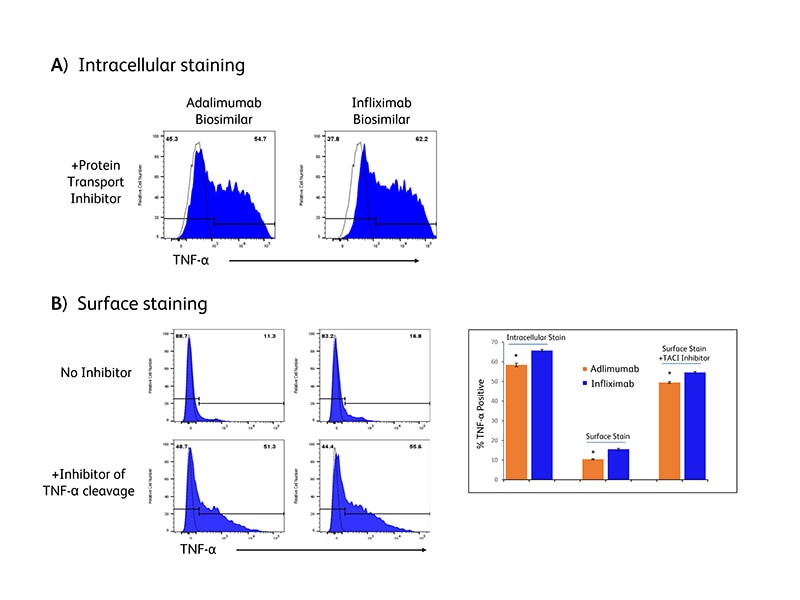
BD Biosimilar Antibodies
| Target | Therapeutic Antibody | Flow Antibodies (N297A mutant) | Wild-type Biosimilar (NA/LE) |
|---|---|---|---|
| CD20 | Rituximab | Explore Conjugates | BD Pharmingen™ Purified NA/LE Anti-Human CD20 Rituximab Biosimilar |
| Obinutuzumab | Explore Conjugates | BD Pharmingen™ Purified NA/LE Anti-Human CD20 Obinutuzumab Biosimilar | |
| Brentuximab | |||
| HER-2 | Trastuzumab | Explore Conjugates | BD Pharmingen™ Purified NA/LE Anti-Human HER-2 Trastuzumab Biosimilar |
| TNF-a | Adalimumab | Explore Conjugates | BD Pharmingen™ Purified NA/LE Anti-Human TNF Adalimumab Biosimilar |
| Infliximab | Explore Conjugates | ||
| CD52 | Alemtuzumab | Explore Conjugates |
For Research Use Only. Not for use in diagnostic or therapeutic procedures.